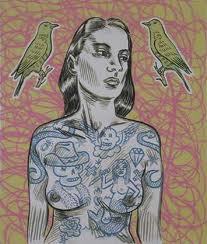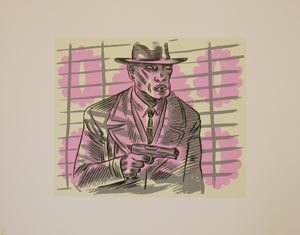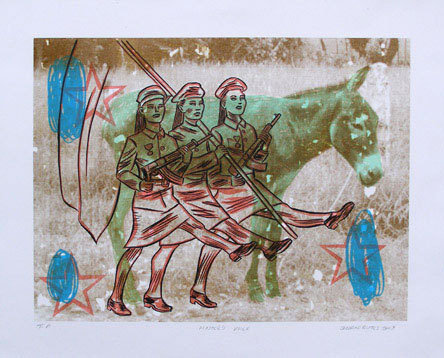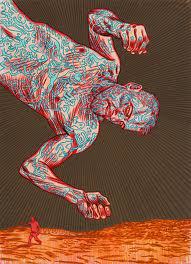Conrad Botes
Conrad Botes was born in 1969 in the Western Cape. Part of his childhood was spent living in a Department of Water Affairs prefab house on the edge of the Theewaters Dam. His father was a teacher at the local school. Listening to Conrad Botes
tell stories of the characters that peopled his childhood world one can see how he has been able to develop his eye
for targeting the soft underbelly of Afrikaanerdom and by extension South African culture. It does not take much to imagine Botes out on Commando during the Boer War and it is this dichotomy between who he physically is and his mental space
that makes his work so powerful.
Together with Anton Kannemeyer, Conrad Botes is one of the founders of Bitterkomix, a rude almost abusive, cutting publication which the two started as students to jolt the establishment and enliven the lives of their gleeful peers, and which is still published regularly. The Bitterkomix publications have grown to be something of a national institution. Botes proudly relates how one of their comics was the first publication to be banned in the free South Africa, and Claudette Schreuders
tells how Kannemeyer and Botes were able to keep their supply of beer going through university with the sale of postcards that they made from Bittercomix.
Conrad Botes elaborates: "With the comics, we're dealing very specifically with a South African audience who know
what we're referring to. Originally we wrote them in Afrikaans, so many of the references are to things in Afrikaans culture.
The paintings I make are much more personal. I can explain them if I have to - but I'd much rather not. It is difficult to explain something that you are meant to feel. People can formulate their own ideas about the work, the viewers reaction is more important than my own explanation".
With his monoprints, silkscreens, lithographs and other work on paper, Conrad Botes indisputably proves his status as 'torchbearer of the Post-Pop movement in South Africa', according to Alet Voster from the AOP gallery.
With his icons of atavistic males and females, including the 'tortured soul' and the femme fatale, Botes mocks conventional notions of individualism and 'humanism', ranging from romantic love to self-flagellation. Botes has been portrayed in critical literature as the 'posthuman' artist par excellence (Ashraf Jamal, 2004). That said, he gives the sweet sentimentality, typical of many of Post-Pop's practitioners, a bittersweet edge in his latest work.
Botes uses Post-Pop's preference for 'sugary infantilism' to reflect on contemporary society. In such a society, religion
is irreverent, violence is desirable, sadism institutionalised, and the individual triumphant in his existential crisis. Botes' work achieves an interesting fusion of the pastoral with contemporary realities and aesthetics: flowers are often wounds
in his works and birds are harbingers of doom. Detached hands refer to creativity.
AVAILABLE WORKS
Masters Voice, Lithograph, 580mm x 470mm
Foreign Affair, Lithograph, 765mm x 575mm
The Other Side of the World, Lithograph, 570mm x 764mm
Reprise I Reprise II
Five colour lithograph, 765mm x 570mm Five colour lithograph, 765mm x 570mm
The big other, four colour lithograph 570mm x 764mm
Liberal communist, three colour lithograph 570mm x 764mm
ARCHIVED WORKS
Haunted, Lithograph 400mm x 530mm
Landscapel I, Three colour lithograph 760mm x 570mm
Landscapel II, Three colour lithograph 760mm x 570mm
Landscapel III, Three colour lithograph 760mm x 570mm














